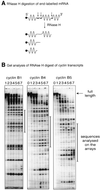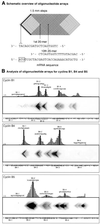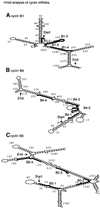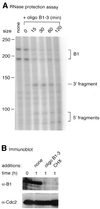Antisense oligonucleotides selected by hybridisation to scanning arrays are effective reagents in vivo
- PMID: 11353073
- PMCID: PMC55457
- DOI: 10.1093/nar/29.10.2041
Antisense oligonucleotides selected by hybridisation to scanning arrays are effective reagents in vivo
Abstract
Transcripts representing mRNAs of three Xenopus cyclins, B1, B4 and B5, were hybridised to arrays of oligonucleotides scanning the first 120 nt of the coding region to assess the ability of the immobilised oligonucleotides to form heteroduplexes with their targets. Oligonucleotides that produced high heteroduplex yield and others that showed little annealing were assayed for their effect on translation of endogenous cyclin mRNAs in Xenopus egg extracts and their ability to promote cleavage of cyclin mRNAs in oocytes by RNase H. Excellent correlation was found between antisense potency and affinity of oligonucleotides for the cyclin transcripts as measured by the array, despite the complexity of the cellular environment.
Figures







Similar articles
-
Selective degradation of targeted mRNAs using partially modified oligonucleotides.Methods Enzymol. 2000;313:420-36. doi: 10.1016/s0076-6879(00)13026-5. Methods Enzymol. 2000. PMID: 10595370 No abstract available.
-
Pathways of degradation and mechanism of action of antisense oligonucleotides in Xenopus laevis embryos.Antisense Res Dev. 1991 Spring;1(1):11-20. doi: 10.1089/ard.1991.1.11. Antisense Res Dev. 1991. PMID: 1668307
-
Targeted degradation of mRNA in Xenopus oocytes and embryos directed by modified oligonucleotides: studies of An2 and cyclin in embryogenesis.Nucleic Acids Res. 1990 Aug 25;18(16):4751-7. doi: 10.1093/nar/18.16.4751. Nucleic Acids Res. 1990. PMID: 1697675 Free PMC article.
-
Rational selection of antisense oligonucleotide sequences.Eur J Pharm Sci. 2000 Sep;11(3):191-8. doi: 10.1016/s0928-0987(00)00100-7. Eur J Pharm Sci. 2000. PMID: 11042224 Review.
-
Unmasking the role of the 3' UTR in the cytoplasmic polyadenylation and translational regulation of maternal mRNAs.Bioessays. 1994 Aug;16(8):533-5. doi: 10.1002/bies.950160804. Bioessays. 1994. PMID: 8086000 Review.
Cited by
-
Rational design and rapid screening of antisense oligonucleotides for prokaryotic gene modulation.Nucleic Acids Res. 2006;34(19):5660-9. doi: 10.1093/nar/gkl715. Epub 2006 Oct 11. Nucleic Acids Res. 2006. PMID: 17038332 Free PMC article.
-
Selection of antisense oligodeoxynucleotides against glutathione S-transferase Mu.RNA. 2002 Dec;8(12):1572-83. RNA. 2002. PMID: 12515389 Free PMC article.
-
Mechanisms of Action of the US Food and Drug Administration-Approved Antisense Oligonucleotide Drugs.BioDrugs. 2024 Jul;38(4):511-526. doi: 10.1007/s40259-024-00665-2. Epub 2024 Jun 25. BioDrugs. 2024. PMID: 38914784 Free PMC article. Review.
-
Antisense phosphorodiamidate morpholino oligomer length and target position effects on gene-specific inhibition in Escherichia coli.Antimicrob Agents Chemother. 2005 Jan;49(1):249-55. doi: 10.1128/AAC.49.1.249-255.2005. Antimicrob Agents Chemother. 2005. PMID: 15616302 Free PMC article.
-
Thermodynamic calculations and statistical correlations for oligo-probes design.Nucleic Acids Res. 2003 Jul 15;31(14):4211-7. doi: 10.1093/nar/gkg476. Nucleic Acids Res. 2003. PMID: 12853639 Free PMC article.
References
-
- Branch A.D. (1998) Antisense drug discovery: can cell-free screens speed the process? Antisense Nucleic Acid Drug Dev., 8, 249–254. - PubMed
Publication types
MeSH terms
Substances
LinkOut - more resources
Full Text Sources
Other Literature Sources
Research Materials

